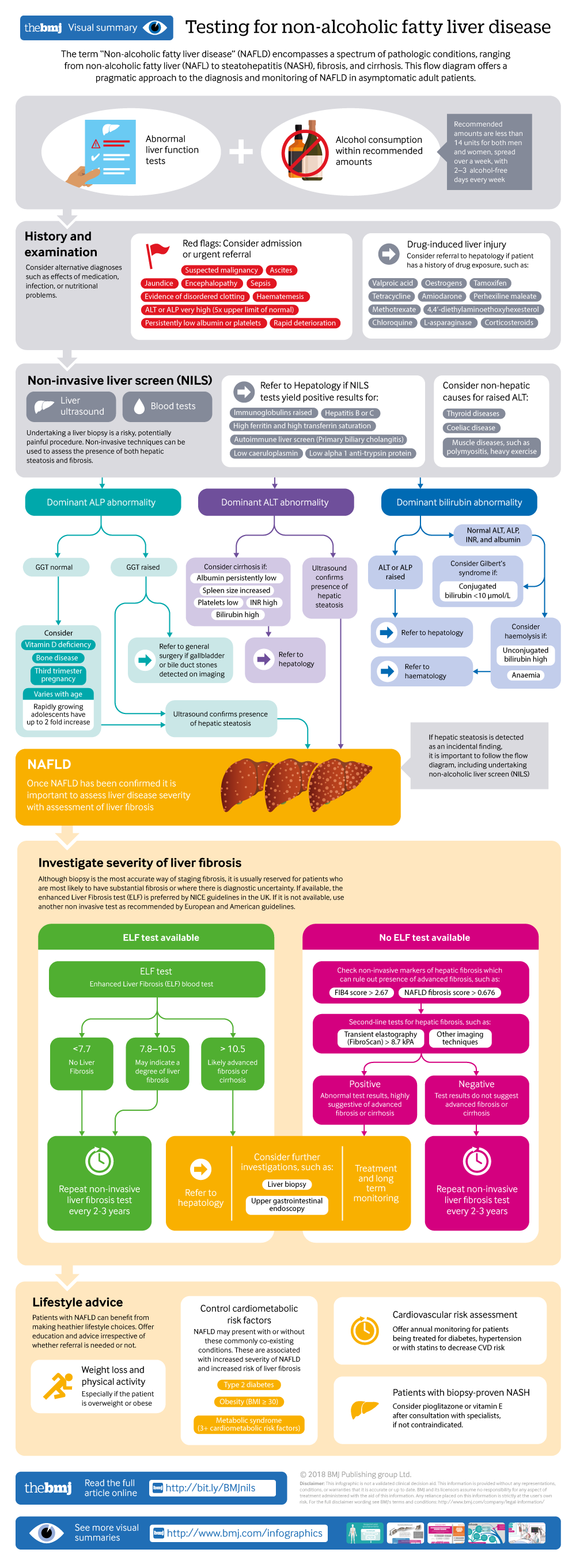Tests for diagnosing and monitoring non-alcoholic fatty liver disease in adults
BMJ 2018; 362 doi: https://doi.org/10.1136/bmj.k2734 (Published 12 July 2018) Cite this as: BMJ 2018;362:k2734
Visual summary available
A flow diagram, detailing a pragmatic approach to testing for NAFLD, including non-invasive screening (ultrasound and blood tests)
- Christopher D Byrne, professor of endocrinology and metabolism1 2,
- Janisha Patel, consultant hepatologist3,
- Eleonora Scorletti, clinical research fellow1 2,
- Giovanni Targher, associate professor endocrinology and metabolism4
- 1Nutrition and Metabolism, Faculty of Medicine, University of Southampton, UK
- 2Southampton National Institute for Health Research Biomedical Research Centre, University Hospital Southampton, Southampton General Hospital, Southampton, UK
- 3Department of Hepatology, Southampton General Hospital, Southampton, UK
- 4Department of Medicine, Section of Endocrinology, Diabetes and Metabolism, Azienda Ospedaliera Universitaria Integrata di Verona, Verona, Italy
- Correspondence to C Byrne cdtb{at}soton.ac.uk
This series of occasional articles provides an update on the best use of key diagnostic tests in the initial investigation of common or important clinical presentations. The series advisers are Steve Atkin, professor of medicine, Weill Cornell Medical College Qatar; and Eric Kilpatrick, division chief, clinical chemistry, Sidra Medical and Research Center, Qatar; honorary professor, department of clinical biochemistry, Hull Royal Infirmary, Hull York Medical School. To suggest a topic for this series, please email us at practice@bmj.com.
What you need to know
Liver ultrasonography is a pragmatic first line test to diagnose hepatic steatosis and exclude other liver pathology in those with non-alcoholic fatty liver disease (NAFLD)
In patients with confirmed hepatic steatosis, use simple non-invasive markers of fibrosis (such as an enhanced liver fibrosis blood test (ELF)) and/or FibroScan to investigate for liver fibrosis
Offer patients with hepatic fibrosis referral for specialist opinion, as hepatic fibrosis is the strongest predictor of overall and liver related mortality in those with NAFLD
At a routine work health check, a 52 year old sedentary computer programmer was found to have a serum alanine aminotransferase (ALT) concentration of 68 IU/L (normal 0-40 IU/L), and a triglyceride concentration of 1.9 mmol/L. His fasting plasma glucose level was 5.8 mmol/L and other basic liver, renal, and lipid blood tests were normal. He had an unremarkable medical history and took no regular medications, did not smoke, and consumed <7 units of alcohol/week. Clinical examination was unremarkable. His body mass index was 29 kg/m2; waist circumference 102 cm, and blood pressure 134/88 mmHg. A repeat serum ALT measurement remained raised some months later, at 62 IU/L.
Non-alcoholic fatty liver disease (NAFLD) is a metabolic liver disease that encompasses a spectrum of progressive pathological conditions, ranging from non-alcoholic fatty liver (NAFL) to steatohepatitis (NASH), fibrosis, and cirrhosis. When hepatic steatosis occurs in …
Log in
Log in using your username and password
Log in through your institution
Subscribe from £173 *
Subscribe and get access to all BMJ articles, and much more.
* For online subscription
Access this article for 1 day for:
£38 / $45 / €42 (excludes VAT)
You can download a PDF version for your personal record.
